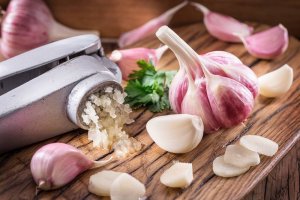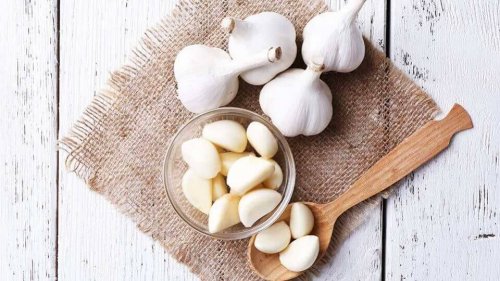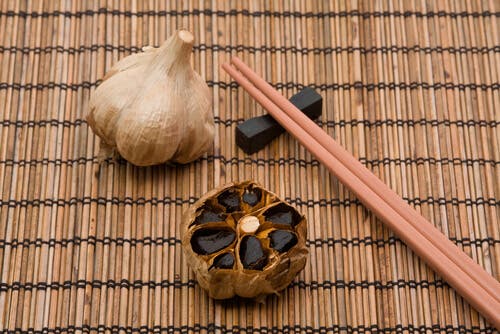How To Reduce Cholesterol with Garlic: 3 Home Remedies

Have you ever wondered whether it’s possible to reduce cholesterol with garlic? You may have heard of the great medicinal values of this food, especially for our cardiovascular health.
In this article, we’ll explain how you can reduce your cholesterol with garlic, as long as you lead a healthy lifestyle and a balanced diet. Studies have shown it’s effective, so you can achieve your goal naturally.
Is it possible to reduce cholesterol with garlic?
People have used garlic for centuries as a medicinal food. Numerous studies have confirmed its positive effects to treat digestive and circulatory problems, coughs, intestinal parasites, pneumonia, and other conditions.
In addition, this food helps to improve your cardiovascular health. It can help lower cholesterol, blood pressure, or platelet aggregation, for example. However, you’ll also need a healthy diet and regular physical exercise.
1. Chew a clove of garlic

The first remedy is the simplest of the 3 to lower cholesterol with garlic. However, there’s one slight drawback – you have to eat raw garlic.
Many people prefer to swallow the clove or parts of it to avoid its taste and odor. However, this study shows that this can reduce its effectiveness, compared to eating it chewed or crushed.
What do you need?
- 1 clove of raw garlic a day
How do you eat it?
- Every day you should eat a clove of raw garlic, chewed or crushed.
- If it’s difficult for you to chew it, you can blend or add it to your food, but always without cooking it.
- You can alleviate the strong taste by chewing some anise seeds or parsley leaves afterwards.
Read also: 4 Habits that Make Your Cholesterol Problem Worse
2. Garlic and lemon juice
This study shows the cardiovascular health benefits of drinking a combination of garlic and lemon juice. The study was done with people between 30 and 60 years of age with moderate hyperlipidemia for 8 weeks. The results of the study were evaluated after two months.
What do you need?
- 8 medium-sized raw garlic cloves
- 1 tablespoon of lemon juice
How do you use it?
- To start, drink the tablespoon of lemon juice on an empty stomach.
- Then, eat the garlic cloves throughout the day, but always raw. You can chop them up to top your food, blend them in gazpacho, spread them on toast, etc.
Read also: A Ginger, Garlic and Honey Remedy for High Cholesterol
3. Black garlic

One of the biggest drawbacks that garlic has if we want to eat it directly is its smell. For this reason, many people reject regular garlic consumption and look for other health alternatives.
However, among the processing methods that have been carried out to eliminate its odor, black garlic has been very successful and is becoming increasingly popular. This type of garlic is obtained by maturing it at high temperature and humidity.
This aging process darkens the color and changes the flavor and texture of garlic. The clove maintains its shape but becomes soft. Additionally, it might remind you of licorice.
We should also highlight that some of its components increase during this maturation process. This means it could be an even more effective as an antioxidant, and also in regulating lipids, including cholesterol.
What do you need?
- Heads of unpeeled garlic
- A container that can maintain a constant temperature between 100°F and 140°F for 1, 2 or 3 months (thermos, yogurt maker, rice cooker, crock-pot, etc.).
- Aluminum foil
How do you make it?
- First, remove just the outer layer of the bulb, not the skin closest to the garlic clove.
- Then, wrap the heads in aluminum foil.
- After that, put the garlic in the container you’ve prepared and leave for at least 2 months. You’ll know it’s ready when the interior turns black. After the first month we can check to see.
- The process is simple, but it requires patience.
How do you eat it?
- You can eat a clove of garlic half an hour before each of your three main meals.
Now you know about three different options to reduce cholesterol with garlic in a simple and natural way. However, before anything else, you should consult your doctor, especially if you suffer from digestive problems or take medications, as it could interfere with your medicines.
All cited sources were thoroughly reviewed by our team to ensure their quality, reliability, currency, and validity. The bibliography of this article was considered reliable and of academic or scientific accuracy.
- Avicenna J Phytomed. 2014 Jan-Feb; 4(1): 1–14. Garlic: a review of potential therapeutic effects. https://www.ncbi.nlm.nih.gov/pmc/articles/PMC4103721/
- Aslani, N., Entezari, M. H., Askari, G., Maghsoudi, Z., & Maracy, M. R. (2016). Effect of garlic and lemon juice mixture on lipid profile and some cardiovascular risk factors in people 30-60 years old with moderate hyperlipidaemia: A randomized clinical trial. International Journal of Preventive Medicine. https://doi.org/10.4103/2008-7802.187248
- Ha, A. W., Ying, T., & Kim, W. K. (2015). The effects of black garlic (Allium satvium) extracts on lipid metabolism in rats fed a high fat diet. Nutrition Research and Practice. https://doi.org/10.4162/nrp.2015.9.1.30
- Jabbari, A., Argani, H., Ghorbanihaghjo, A., & Mahdavi, R. (2005). Comparison between swallowing and chewing of garlic on levels of serum lipids, cyclosporine, creatinine and lipid peroxidation in Renal Transplant Recipients. Lipids in Health and Disease. https://doi.org/10.1186/1476-511X-4-11
- Nutrition Research and Practice. 2015 Feb;9(1):30-36. English. The effects of black garlic (Allium satvium) extracts on lipid metabolism in rats fed a high fat diet. https://doi.org/10.4162/nrp.2015.9.1.30
This text is provided for informational purposes only and does not replace consultation with a professional. If in doubt, consult your specialist.








